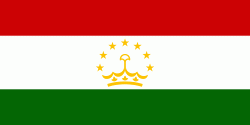Gharm (Rasht)
Gharm (Ғарм, tr. Gharm; Гарм, tr. Garm;, tr. Gharm) is a city and jamoat in the Rasht Valley area of central Tajikistan. The population of the town is 9,800 (January 2020 estimate).
From the 1920s until 1955 there was a Gharm Oblast in Tajikistan, which included the territory of the current Gharm Valley. Gharm is also the former name of the Rasht District in central Tajikistan.
During the 1920s Gharm was a hotbed for the Basmachi, the anti-Soviet resistance in Central Asia. In 1929 Basmachi commander Faizal Maksum crossed from Afghanistan into Tajikistan and briefly captured Gharm, only to later be expelled by Soviet forces.
During the Civil War in Tajikistan from 1992 to 1997, Gharm was a hotbed for the opposition force, and the town was controlled by the opposition during the later part of the civil war in Tajikistan. In October 2010, the Tajik Interior Ministry asserted it had killed three militants on the outskirts of Gharm amid an alleged rise in Islamic militancy in the region.
From the 1920s until 1955 there was a Gharm Oblast in Tajikistan, which included the territory of the current Gharm Valley. Gharm is also the former name of the Rasht District in central Tajikistan.
During the 1920s Gharm was a hotbed for the Basmachi, the anti-Soviet resistance in Central Asia. In 1929 Basmachi commander Faizal Maksum crossed from Afghanistan into Tajikistan and briefly captured Gharm, only to later be expelled by Soviet forces.
During the Civil War in Tajikistan from 1992 to 1997, Gharm was a hotbed for the opposition force, and the town was controlled by the opposition during the later part of the civil war in Tajikistan. In October 2010, the Tajik Interior Ministry asserted it had killed three militants on the outskirts of Gharm amid an alleged rise in Islamic militancy in the region.
Map - Gharm (Rasht)
Map
Country - Tajikistan
 |
 |
| Flag of Tajikistan | |
The territory that now constitutes Tajikistan was previously home to several ancient cultures, including the city of Sarazm of the Neolithic and the Bronze Age and was later home to kingdoms ruled by people of different faiths and cultures, including the Oxus civilization, Andronovo culture, Buddhism, Nestorian Christianity, Hinduism, Zoroastrianism, Manichaeism, and Islam. The area has been ruled by numerous empires and dynasties, including the Achaemenid Empire, Sasanian Empire, Hephthalite Empire, Samanid Empire, and Mongol Empire. After being ruled by the Timurid Empire and Khanate of Bukhara, the Timurid Renaissance flourished. The region was later conquered by the Russian Empire and subsequently by the Soviet Union. Within the Soviet Union, the country's modern borders were drawn when it was part of Uzbekistan as an autonomous republic before becoming a full-fledged Soviet republic in 1929.
Currency / Language
| ISO | Currency | Symbol | Significant figures |
|---|---|---|---|
| TJS | Tajikistani somoni | ЅМ | 2 |
| ISO | Language |
|---|---|
| RU | Russian language |
| TG | Tajik language |















